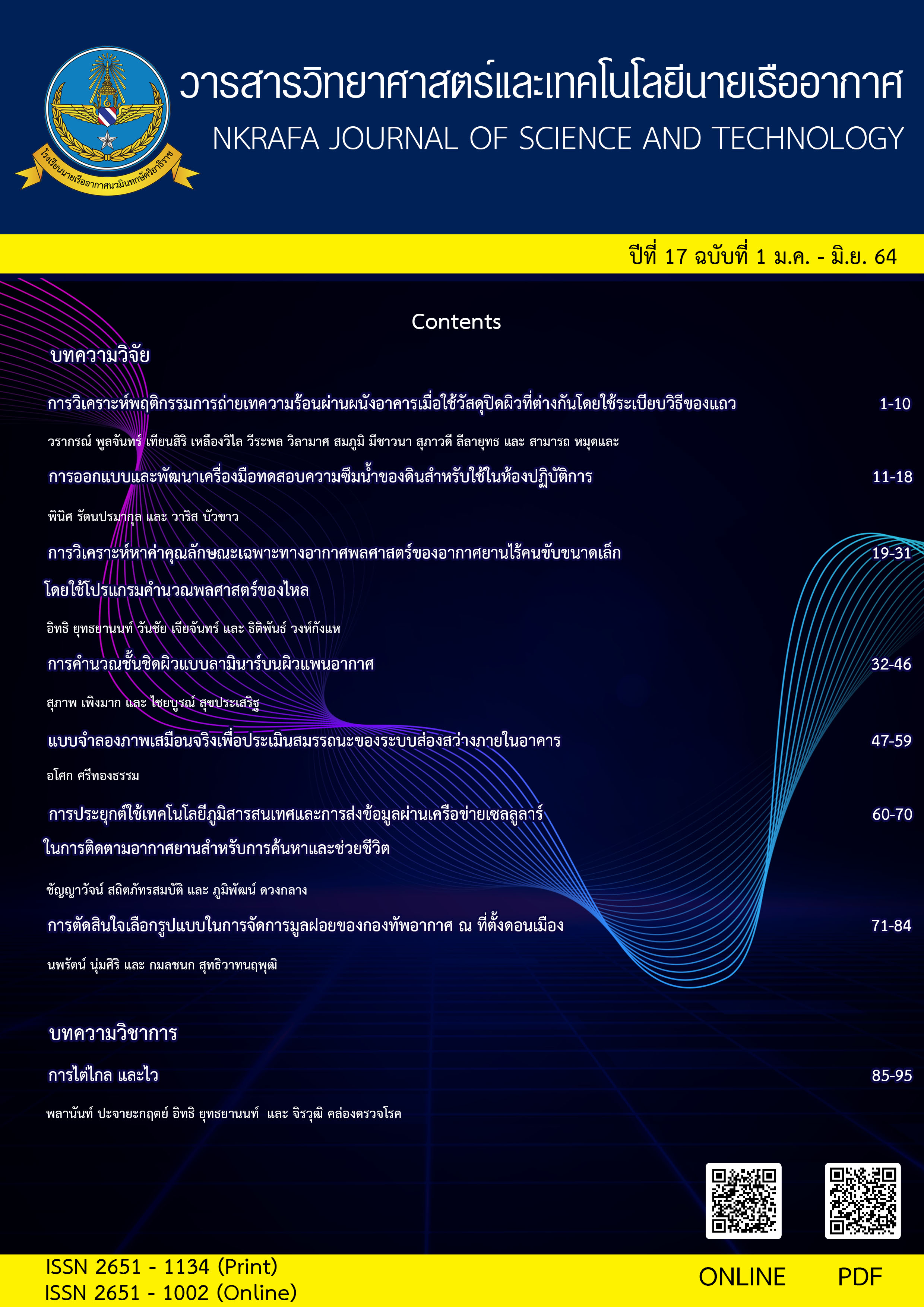Design and Development of Soil Permeability Testing Apparatus for Use in Laboratory of the Department of Civil Engineering, Navaminda Kasatriyadhiraj Royal Air Force Academy
Main Article Content
Abstract
This research studied to design and develop the apparatus of soil permeability test for use in soil mechanics laboratory in civil engineering department, Navaminda Kasatriyadhiraj Royal Air Force Academy. The research methodology involves stages of collecting the related information, designing and manufacturing the equipment set of soil permeability test with available and inexpensive materials. The soil permeability test was then performed on soil samples with the developed equipment. The obtained results were compared with the soil sample that was tested by an outsourcing laboratory, and then the step of discussion and conclusion were performed. After testing and solving some defect, it was found that the coefficients of permeability of soil samples obtained from the developed equipment are corresponding with the typical values as previously proposed. Moreover, the variance of the results obtained from the test were relatively small and the discrepancy between the results and the value obtained from the test performed by outsourcing laboratory is approximately 12 - 14%. Therefore, it can be concluded that the developed soil permeability testing apparatus provides acceptable test results and also, its production costs is relatively low. The developed equipment is thus suitable for use in soil mechanics laboratory in civil engineering department, Navaminda Kasatriyadhiraj Royal Air Force Academy for the benefit of future education and research.
Article Details

This work is licensed under a Creative Commons Attribution-NonCommercial-NoDerivatives 4.0 International License.
- Content and information in articles published in NKRAFA Journal of Science and Technology are comment and responsibility of authors of articles directly. Journal editorial do no need to agree or share any responsibility.
- NKRAFA Journal of Science and Technology Articles holds the copyright of the content, pictures, images etc. which published in it. If any person or agency require to reuse all or some part of articles, the permission must be obtained from the NKRAFA Journal of Science and Technology.
References
[2] สยาม แกมขุนทด, พานิช วุฒิพฤกษ์, สันชัย อินทพิชัย และ พิทยา แจ่มสว่าง. (2558). “ตัวแปรที่มีผลกระทบต่อค่าสัมประสิทธิ์การซึมผ่านของน้ำในดินลูกรังที่มีขนาดคละแตกต่างกัน” กรุงเทพฯ: วารสารวิชาการพระจอมเกล้าพระนครเหนือ, 25(1), ม.ค. – เม.ย. 2558: 11 – 19.
[3] วิทยาลัยเทคนิคเชียงใหม่. “หน่วยที่ 11 การทดลองความซึมน้ำของดิน (Soil Permeability Test)” เอกสารประกอบการสอนรายวิชาปฏิบัติการปฐพีกลศาสตร์, สืบค้น 14 สิงหาคม2563, จาก http://krumanit.cmtc.ac.th/main/images/stories
/11.pdf.
[4] Das, B. M. (2010). Principles of Geotechnical Engineering: 7th edition. USA: Cengage Learning.
[5] ก้องเกียรติ บุณฑริก และฌาธร ลอยจิ๋ว. (2545). เครื่องมือทดสอบการไหลซึมของน้ำผ่านดินแบบระดับน้ำแปรเปลี่ยน. (ปริญญานิพนธ์หลักสูตรวิศวกรรมศาสตรบัณฑิต, สถาบันเทคโนโลยีราชมงคล วิทยาเขตเทคนิคกรุงเทพฯ).
[6] ปิติ อังสุโวทัย. (2525). “ความซึมผ่านได้ของดินผสมปูนขาว” ขอนแก่น: วิศวกรรมสาร มข. ปีที่ 9(3), ก.ค. – ก.ย. 2525.
[7] อติเทพ ศรีคงศรี (2556). “เสถียรภาพต่อการกัดเซาะภายในโครงสร้างมวลดิน: หัวข้อแนะนำให้เพิ่มในตำราวิชาปฐพีกลศาสตร์” กรุงเทพฯ: วิศวกรรมสารเกษมบัณฑิต ปีที่ 3(2), ก.ค. – ธ.ค. 2556.
[8] ASTM D2434 - 68 (reapproved 2006). Standard Test Method for Permeability of Granular Soils (Constant Head). American Society for Testing and Materials. West Conshohocken, PA, USA.
[9] ASTM D5856-15. Standard Test Method for Measurement of Hydraulic Conductivity of Porous Material Using a Rigid-Wall, Compaction-Mold Permeameter. American Society for Testing and Materials. West Conshohocken, PA, USA.


